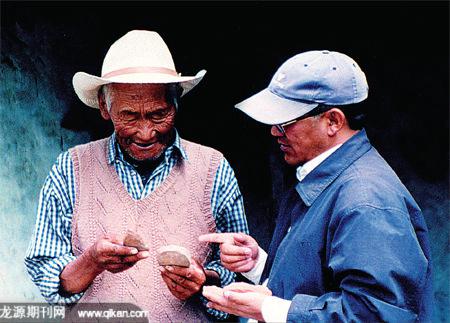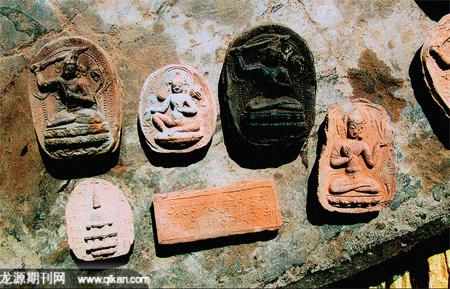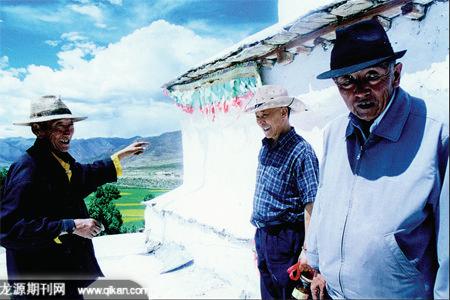Tsha-Tsha Unearthed during the Period of Gyama Gandenpa
2008-04-10Sonchung
Sonchung
One day in July 2007, Horkhang Changpa Tendar told me that they had discovered a group of Tsha-Tsha in the ruin of Lhakhang Chemo (a chamber) in Gyama Town, which they believed belonged among relics from the period of Gadam Pa and had never been discovered before. He also asked us to come to see what they were.

Gyama Palace at Gyama Town
Gyama Town is situated at Medrogungkar County, 70 kilometers from west Lhasa. It was the political center during the Tubo Kingdom. On a map, you will see that Tsethang, where Yarlung Tribe were living during the Tubo Kingdom, is south of Gyama, but Mt. Gangdise divides them. In the sixth century Namri Songtsen, the father of Songtsen Gampo crossed over the mountain path of the Yarlung Zangbo River to arrive at Medrogungkar. Having taken over the Sumpa Tribe, north of Lhasa, he settled at Medrogungkar. Legend says Songtsen Gampo was born in Kgya Ma Mi Jigs Palace in Medrogungkar.
The ruin of Gyama Palace is situated southwest of Medrogungkar County and adjacent to the Samye Monastery. In 1640, Gushri Khan, the Mongolian chieftain, invaded Tibet and fought against local Tibetans, resulting in the destruction of many ancient buildings. Though the sixth century Palace was ruined, the castle was still there in 1960. People believe the castle is steeped with the history of a thousand years, and therefore should be the fortification of the Sumpa Tribe. There are enormous holes in the wall of the castle for archers to shoot arrows through. Horse traps and a city moat surround it. Khri Khang Village is one of the most precious ancient sites in Gyama Town in Lhasa, enriched by splendid scenery and abundant culture, attracting tourists from around the world.
The village is also the hometown of Horkhang Changpa Tendar. Having been influenced by his father, the famous scholar Horkhang Sonam Benpa, Horkhang Changpa Tendar takes a special interest in the cultural development of his hometown. In 1991, old Korkhang donated funds to renovate three stupas that were ruined during the Cultural Revolution. During the renovation, they found many ancient Tsha-Tsha. They collected all ofTsha-Tsha to keep in the stupas in order to preserve these cultural relics.
Tsha-Tsha in Tibet
Tsha-Tsha is a typical tribute in accordance with Tibetan Buddhism, made by Tibetan clergy and layman. Tsha-Tsha is referred to as holy articles to show benevolence and an amulet to prevent people from catastrophe and harm. Usually, it is used to put inside of the Buddhist statues or stupas.
When I traveled in Tibet, I heard some strange tales about how farmers dealt with Tsha-Tsha. For instance, some of them prefer to throw Tsha- Tsha into a river, symbolizing purity; others might smash Tsha-Tsha to powder and then feed it to their livestock to acquire fertility.

According to scholars, the words Tsha-Tsha have three different origins. Firstly, people believe it originated from the dialect of the middle and north part of ancient India and a transliteration from Sanskrit into Tibetan language, which is still used in Tibetan inhabited areas in the Tibetan Autonomous Region, Qinghai, Sichuan, and Gansu; secondly, some people claim that the name Tsha-Tsha is actually derived from the sound of making Tsha-Tsha; lastly, in Tibetan, Sa or Cha means the Earth. The word Tsha-Tsha should originally have been Sa Tsha or Cha Tsha, i.e. earth Tsha, which might be close to the original meaning. In short, Tsha-Tsha refers to earthen Buddhist statues and stupas made by placing earth or Assuming Tsha-Tsha originated from a dialect of ancient India, Tsha- Tsha means replication but refers to earthen statues and stupas. The first Tsha-Tsha discovered were Indian style, usually made with red fictile china. The rim of such Tsha- Tsha is irregular, and motifs on it might display as auspicious stupa or pagodas of Bodhi stupa, engraving with Hannya Shingyo. Eventually Tibetans started to make their own form of Tsha-Tsha, varying in styles. After the 13th Century, with the spread of Tibetan Buddhism, the Tibetan style Tsha-Tsha was transferred to Hangzhou, Beijing, and other places in hinterland. That is why Han Chinese literature included the phrase “mould earth statues of Buddha”.

Tsha-Tsha appeared in Tibet in the 10th Century. It is said that Tsha-Tsha had already existed during the early boom period of Buddhism, but this conclusion needs more evidence to verify it. Production of Tsha-Tsha peaked when Atisha came to Tibet. Today, ruins of the Guge Kingdom in Ngari still have a large number of stupas, in which enormous Tsha-Tsha in a variety of shapes are preserved. The earliest Tsha-Tsha we can see today is those from this period, including Pabongka Temple situated at in north Lhasa. Atisha ever practiced meditation there. The popularity of Tsha-Tsha was greatest about the 13th to 15th Century, and Tsha-Tsha was widely used for different purposes, such as preserving in stupas, taking as tributes to altars, being used as amulets or apotropaion, to ward off evil. It was in this period that Tsha-Tsha had become very much a part of Tibetan peoples daily lives. Since then, the display of Tsha-Tsha has been enormous, such as vivid Buddhist statues, Bodhisattva, warriors, and eminent monks. It is not exaggerated in words, if Tsha-Tsha is referred as to as a display of Buddhist religion in a mini world.
Tsha-Tsha unearthed in Gyama Town
In recent years, Tibet launched the campaign to build new socialism villages. In January of 2007, when farmers from Khringkhang Village in Gyama Town dug the earth forconstruction of their new houses, a sevenyear- old boy accidentally found several Tsha-Tsha. He handed them over to his teacher named Badro. Having been informed by Badro by phone, Changpa Tendar took three visits to Gyama to study this discovery and wrote a report to local government suggesting preservation. To protect the Tsha-Tsha from rain, Changpa Tendar worked together with monks from Rabrgyas Gling Lhakhang to collect ten big bags of Tsha-Tsha, which were lying on the ground, and buried again those Tsha-Tsha that had been difficult to dig out.
The group of Tsha- Tsha was discovered at the right side of Rabrgyas Gling Lha- Khang, which is a large ruin located ten metres away. According to the literature, this ruin should be the place where Gyama Lha Khang Chemo was destroyed by fire.
Since the 12th Century, Gyama in Medrogungkar had become another holy place of rejuvenation for the Bka Gdang Sect after the Reting Monastery. During the period of Tsongkhapa, only Rinchengang Monastery had over 800 monks. In 1090, Ger Gompa Shonnu Drakpa, the disciple of Gadam Rgya Bzhiba was born inGyama Nangdar. In 1119, Gashi Ger Gompa built Gyama Rinchengang, while setting up the upper chamber and lower chamber in the compound.
In 1138, again, another famous eminent monk of Gadam Sect, Sangyewon Shonnu Chongnas, was also born in Gyama Nangdar. Legend has it that Sangyewon showed extreme talent when he was a child. He could leave his footprints on stone. He became a monk when he was a child. In 1162, he built Lhakhang Chemo, using 80 pillars, and also affiliated buildings by which he had contributed great value to Gadam Sects development.

The question is why we could not see the famous Lhakhang Chemo nowadays at Gyama Town?
Historically, Gyama Khringkhang, just like other places in Tibet, has had a violent history. Standing aside with Lhazang Khan during the fight between Dzungar Mongols and Lhazang Khan, Gyama Lhakhang Chemo suffered the greatest destruction. Later, several epidemics of smallpox caused many deaths resulting in a bankrupt economy and culture. However, the destruction of Lhakhang Chemo was really because of fire. According to the famous scholar Pawo Tsuglag Trengwa, “Grodgon Sangyewon is the incarnate of Lama Rgya Bzhiba... when I was just 33, Lhakhang Chemo was burnt by fire.” Pawo Tsuglag Trengwa was born in 1504, therefore, Gyama Lhakhang Chemo must have been burnt about 1536.
Without any other evidence to verify that this is the ruin of Lhakhang Chemo that was burnt down, this new discovery of the group of Tsha-Tsha might be good corroboration.
Firstly, these thousands ofTsha- Tsha were unearthed from one metre underground in the ruin of Lhakhang Chemo. Evidence of a fire was also found, such as burn wood plates (which were usually used as covers to protect books) and iron linkers to tie books. The shape of some iron linkers was distorted because of fire. It was clear evidence that there was a big fire. In addition, after the fire, this ruin was never dug and later generations built houses on it because nobody knew Tsha-Tsha were preserved there. The Tsha-Tsha discovered is mostly stupas, including Buddha, Bodhisattva, Tara, and diamond warriors. These four Buddha are actually the key Buddha of Bka Gdang Sect.
As early as “the later prosperity of Tibetan Buddhism” (about the 11th - 12th Century), the peripheral area of Gyama was where the Bka Square, round, and rectangular shaped Tsha-Tsha, unearthed in May of 2007.
Gdang Sect prospered. Until the 13th Century Bka Gdang Sect still prevailed. In history, Gyama Town is abundant with many religious sites from the period of the Bka Gdang Sect to the Gelug Sect. The records in ancient literature describing “Four caves and eight monasteries” could even find their traces today.
In comparison with the unearthed Tsha-Tsha in the early or later period of Guge Kingdom in Ngari, the ones from Ngari were usually the earthen Tsha-Tsha made by pressing materials into moulds, but the ones from Gyama were fired pottery Tsha-Tsha. The difference is because of the geographic locality and available materials. Medrogungkar, since ancient times, has been the most popular place to produce pottery. Tharpa of Medrogungka still produces pottery Tsha-Tsha today. In according to Zhang Zhongxian from the Tibetan Federation of Literary and Art Circles, the pottery Tsha-Tsha unearthed at Tharpa is mostly rectangular, square, and peach-like in shape. Such kind of pottery Tsha-Tsha is made by using earth powder mixed with a few plants and barley; adding water in order to make it soft, the mixed materials are placed into a mould until half dry. On removing from the mould, the figures are usually perfect in shape. After completely dried, they are coloured with dyes and then fired in a pottery oven.

In accordance with Li Yizhi, a collector of Tsha-Tsha, “During this period (the 12th Century), the phenomena of Tsha-Tsha being made as pottery, appeared at almost the same time as it is showed up in the west area of Tibet and other Tibetan inhabited areas as well. Pottery Tsha-Tsha is much harder than earthen ones and easier to keep. Therefore, the transformation of Tsha-Tsha from earthen made to pottery was the trend. This period was just the beginning of the transformation. However, the technology during this period was too weak to make Tsha-Tsha perfectly. For example, the temperature could not meet the standard of professional pottery. Therefore, the Tsha-Tsha produced were usually in transition between earthen made and pottery. Only few were authentic pottery Tsha-Tsha, with a beautiful yellow or black colour.” The recovered Tsha-Tsha unearthed in Gyama look natural in colour, attractive and diverse. Some of them are extremely high quality and beautiful. After comprehensive analysis, people argue that the age of the Tsha-Tsha might not be as early as some imagination, or some might be products of earlier years. Several small black Tsha-Tsha were found to have Gupta calligraphy written on them. It could be identified as being earlier than the 12th Century. Nevertheless, they are precious relics in terms of value and history.
Horkhang Changpa Tendar, at 62 years old, has done great work on the study andpreservation of Tsha- Tsha, aiming to pass on the rich cultural knowledge of Gyama Town. He wants to preserve and advance the local culture through the positive impact of the tourist industry. I believe his dream will soon become reality.
